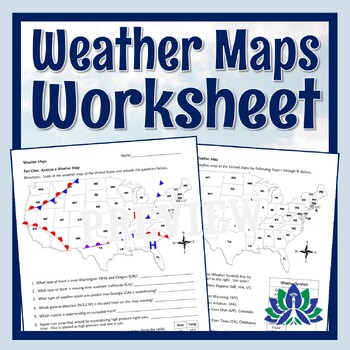Weather Fronts Weather Maps Worksheet Middle School MS-ESS2-5
Flying Colors Science
4.8k Followers
Grade Levels
6th - 8th
Subjects
Resource Type
Standards
NGSSMS-ESS2-6
NGSSMS-ESS2-5
Formats Included
- PDF
Pages
2 pages
Flying Colors Science
4.8k Followers
What educators are saying
This was a great way to review after our weather unit! It brought everything together and students were very engaged!
I loved the fact that it was a great use of a weather map with questions that are aligned to the TEKS.
Also included in
- SAVE MORE THAN 35% OFF LIST PRICES! Review and reinforce middle school NGSS weather concepts.Included Worksheets:Weather Review Weather InstrumentsWeather Fronts/MapsRelative HumidityIndividual Descriptions:Weather Review: 4 CONTENT-DENSE PAGES - 42 question standards-based weather worksheet for hPrice $9.99Original Price $15.48Save $5.49
- Never search for "something to do tomorrow" ever again! This bundle contains PRINT AND GO lessons, NO PREP activities, LOW PREP labs, and ENGAGING articles to supplement and thoroughly enhance an Earth and space science course. Every included resource is easy to implement, standards-based, and high-Price $399.99Original Price $649.02Save $249.03
Description
Give students extra practice with this weather map activity! This worksheet includes two parts:
- Part One - Students look at a weather map and answer questions about the weather fronts shown on it.
- Part Two - Students follow directions to create their own weather map.
Included Terms: warm front, cold front, occluded front, stationary front, high pressure area, low pressure area
⭐Get this worksheet at a huge discount in our Weather Worksheet Bundle!
Teacher Notes:
- INCLUDES ANSWER KEY.
- Please note that this resource is not editable.
⭐⭐⭐Click here to get 5 FREE EARTH & SPACE SCIENCE lessons!⭐⭐⭐
Total Pages
2 pages
Answer Key
Included
Teaching Duration
N/A
Report this resource to TPT
Reported resources will be reviewed by our team. Report this resource to let us know if this resource violates TPT’s content guidelines.
Standards
to see state-specific standards (only available in the US).
NGSSMS-ESS2-6
Develop and use a model to describe how unequal heating and rotation of the Earth cause patterns of atmospheric and oceanic circulation that determine regional climates. Emphasis is on how patterns vary by latitude, altitude, and geographic land distribution. Emphasis of atmospheric circulation is on the sunlight-driven latitudinal banding, the Coriolis effect, and resulting prevailing winds; emphasis of ocean circulation is on the transfer of heat by the global ocean convection cycle, which is constrained by the Coriolis effect and the outlines of continents. Examples of models can be diagrams, maps and globes, or digital representations. Assessment does not include the dynamics of the Coriolis effect.
NGSSMS-ESS2-5
Collect data to provide evidence for how the motions and complex interactions of air masses result in changes in weather conditions. Emphasis is on how air masses flow from regions of high pressure to low pressure, causing weather (defined by temperature, pressure, humidity, precipitation, and wind) at a fixed location to change over time, and how sudden changes in weather can result when different air masses collide. Emphasis is on how weather can be predicted within probabilistic ranges. Examples of data can be provided to students (such as weather maps, diagrams, and visualizations) or obtained through laboratory experiments (such as with condensation). Assessment does not include recalling the names of cloud types or weather symbols used on weather maps or the reported diagrams from weather stations.







